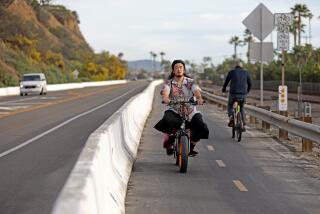Fund to Lower Vehicle Emissions Called ‘Boondoggle’ : Smog: A Costa Mesa firm would get about $37,000 per issue for newsletter. O.C. would get about $722,000. Critics say program would do little to improve air.
- Share via
A fund of more than $10 million, designed to help local governments lower vehicle emissions, has been targeted by critics as an expensive “boondoggle” that would do little to improve the quality of air in the Southland.
The South Coast Air Quality Management District received 310 proposals for a chunk of the funding, which comes from a $4 surcharge on all vehicle registrations. The district’s board is scheduled to give final approval to 62 programs today.
Now in its second year, the program is supposed to finance innovative plans and help local governments pay for requirements of new air quality rules. But among the proposals up for approval are a bimonthly newsletter that will cost $222,575 (or $37,955 per issue) and a program of traffic light synchronization in western San Bernardino county that other cities already are doing on their own. It costs about about $4,000 per light.
Another proposal is for a phone-in service whereby drivers can call for route and traffic information, similar to a service already offered by PacTel Cellular. In addition, a certification course in transportation planning offered by UC Riverside Extension is set for approval. It will cost roughly $1,900 per student, five times the cost of a similar program at UCLA.
“We’re so desperate to apply the money to help cities and counties to grapple with the Air Quality Management Plan,” said AQMD board member Sabrina S. Schiller, who called the disbursement a “boondoggle” at the board’s November meeting. “Piddling it away on these things breaks my heart.”
Orange County would get a total of about $722,000 under the proposal, mostly for providing bus service and bicycle equipment.
Judy Hathaway-Francis, chairwoman of the independent committee that sifted through the 310 proposals before recommending 62 to the AQMD board, did not return repeated telephone calls.
Bill Kelly, an AQMD spokesman, said last year’s funding decision generated little controversy. “I would suspect that, on this type of thing, there would always be (concerns about) particular proposals,” he said.
Although more than 60% of the air pollution in the South Coast Air Basin comes from cars, trucks and buses, the money to support air quality measures has traditionally come from fees and fines on businesses and industry, or so-called stationary sources.
In 1990, legislation was passed authorizing an additional fee on motor vehicle registrations to fund programs to cut vehicle pollution. The fees-- which have been upped to $4 from an initial $2--are collected by the Department of Motor Vehicles and distributed by the AQMD. Last year about $6.7 million was used to fund 42 different proposals.
None of the program’s detractors criticizes the basic idea, and many of the proposals likely to be passed today are admirable, they say. But the final list of 62--to be funded at levels ranging from about $5,000 to nearly $400,000--is punctuated with ideas that are “questionable” and “outrageous,” according to Schiller and other critics.
Several pointed to the bimonthly newsletter proposed by Paine & Associates, a Costa Mesa public relations firm. There is no line-item veto by the AQMD board, so if whole package of proposals is approved as recommended, Paine & Associates would get $222,575 for its project.
“That’s about $37,000 per issue,” said Paul Staples, president of an alternative energy firm called Clean Air Now, which was turned down in its bid for funding. “I could probably produce it on my desktop publishing system for a fraction of the cost. I could do a year for $37,000.”
But David Paine, president of Paine & Associates, contends his project is being unfairly characterized. He called his proposal, which is primarily meant to push car-pooling to commuters who work for small companies, “an incredibly complex, complicated behavioral-modification program that includes a newsletter . . . an oversized four-color tabloid. This is an excellent project.”
The UC Riverside Extension’s certification program in transportation planning, costing around $1,900 per student, drew fire from Joel Schwartz, staff scientist for the environmental group Coalition for Clean Air. Schwartz, whose coalition also turned down for funding, noted that UCLA Extension offers a certificate in transportation demand management for $375.
But Jon Kindschy, a continuing education specialist at UCR, said there are differences in the two programs. The UCLA program, he said, is intended to train transportation coordinators at large companies. His program “is for city and county and Caltrans planners, a different audience,” he said. “This is tantamount to a ‘master’s degree’ in transportation planning.”
Under the proposal, the Orange County Transportation Authority would receive about $274,000 for dual-fuel and diesel buses, and $65,000 for providing bike racks, lockers and other equipment for cyclists. Also, the county would get $140,000 to help implement the region’s clean-air rules by creating a manual and obtaining technical assistance.
Other projects are nearly $150,000 to Laguna Beach for converting gasoline vehicles to propane, $50,000 to Anaheim for express bus-pool service, $38,000 to MainPlace mall in Santa Ana for ridesharing and nearly $5,000 to Fullerton to buy bicycles to loan to employees.
More to Read
Sign up for Essential California
The most important California stories and recommendations in your inbox every morning.
You may occasionally receive promotional content from the Los Angeles Times.














